How Much is a 1934 $20 Bill Worth? (Series “A”, “B”, “C”, “D”)
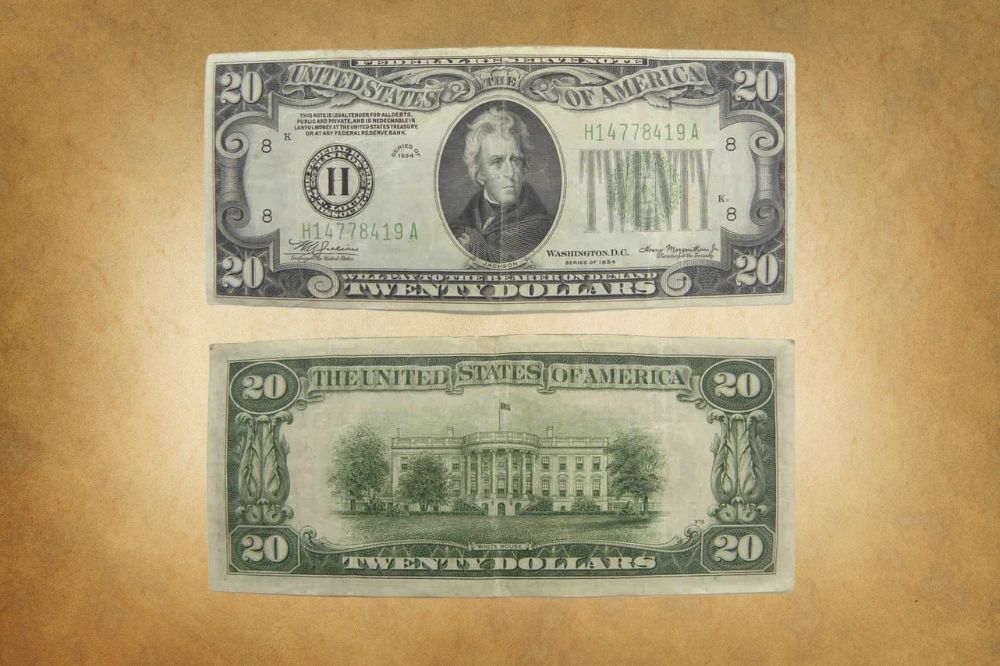
The US Federal Reserve Bank printed the first large-size $20 bills in 1861, and these gold certificate banknote production ended with the small-size 1928 $20 bills. You can find five series with a green seal and two valuable series from Hawaii with a brown seal printed in 1934.
The 1934 $20 bill value is always far higher than its face value. This small-size banknote features President Jackson’s portrait on the front page and the White House on the back page.
1934 small size $20 bill value |
|||
| Series | Bills in uncirculated condition | Bills in circulated condition | Bills with a star (★) |
| *by Old Money Prices | |||
| 1934 with a green seal | $100 | $30 to $40 | $225 |
| 1934 (Hawaii) with a brown seal | $1,250 | $75 to $125 | $3,000 |
| *by Silver Recyclers | |||
| 1934 with a green seal | $70 to $115 | $20 to $50 | $85 to $675 |
| 1934 A with a green seal | / | / | $75 to $150 |
| 1934 B with a green seal | / | / | $125 to $650 |
| 1934 C with a green seal | / | / | $80 to $450 |
| 1934 D with a green seal | / | / | $110 to $625 |
| 1934 (Hawaii) with a brown seal | $2,500 | $125 to $300 | Several thousands of dollars |
| 1934 A (Hawaii) with a brown seal | $775 | $110 to $165 | Several thousands of dollars |
| *by Variety & Errors | |||
| 1934 | $75 | $25 to $35 | $175 |
| 1934 A, B, C, and D with a green seal | $40 to $75 | $20 to $35 | $300 to $500 |
| 1934 Hawaii with a brown seal | $1,000+ | $50 to $150 | $2,000 |
| 1934 A Hawaii with a brown seal | $900 | $30 to $60 | $2,000+ |
1934 $20 Bill Value Guides
As I have already mentioned, you can recognize five 1934 $20 bill types and two printed in Hawaii. Their value depends on the condition and variation.
1934 $20 bill value
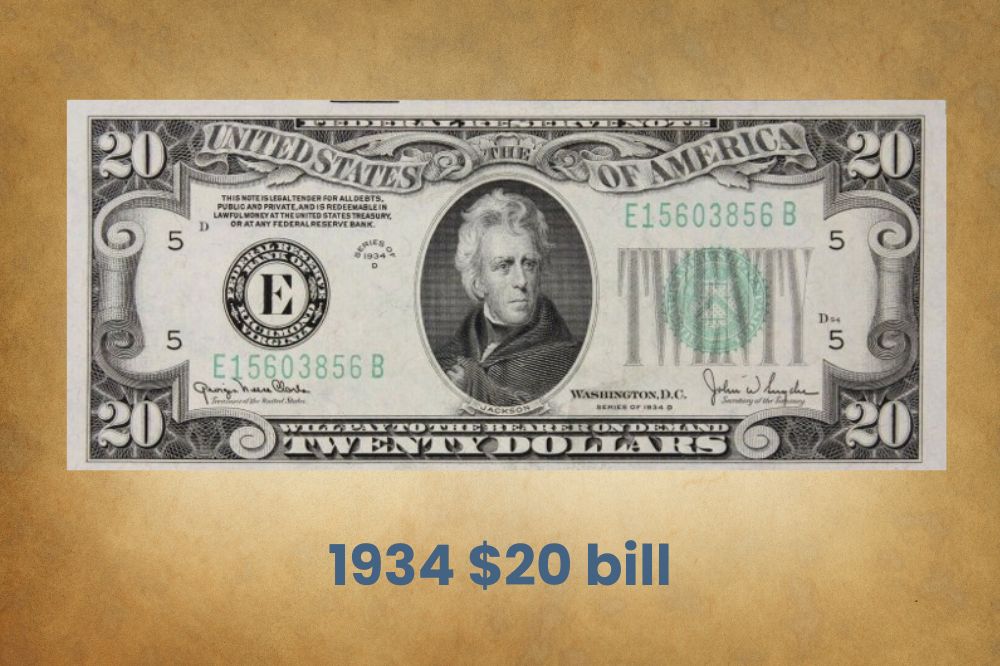
This banknote with a green seal is typically worth $20 to $40 when it is in circulation condition, sometimes $50 for well-preserved ones. On the other hand, you should set aside about $75 to $100 for a piece in perfect condition.
Since those with a star are rare, most collectors are prepared to pay a few hundred dollars for one of them, depending on the condition.
1934 A, 1934 B, 1934 C, and 1934 D $20 bill value
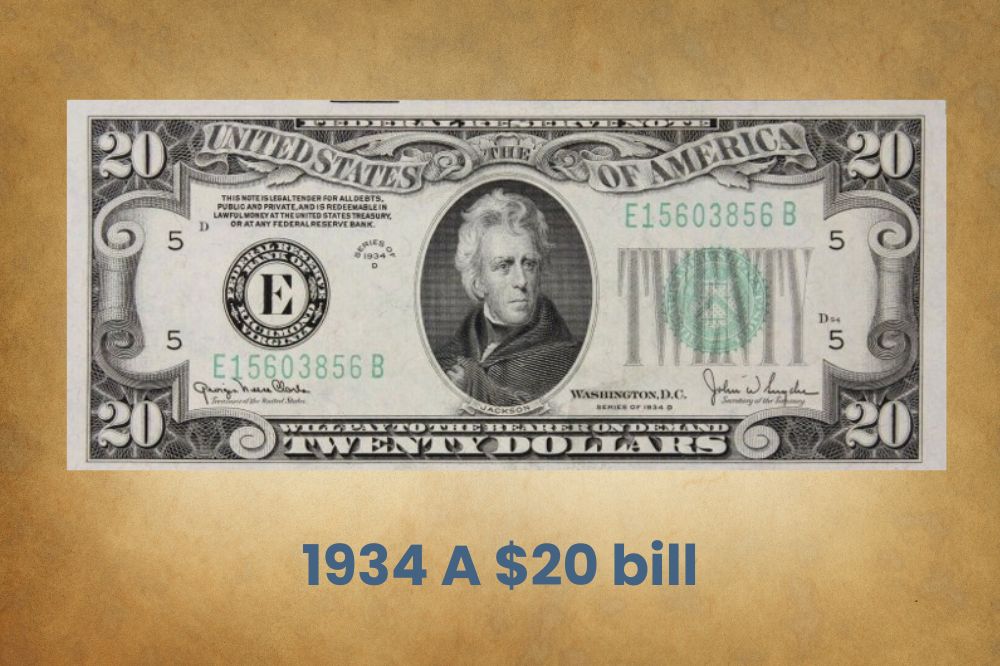
Most of these notes are less expensive than the first printed series, and you can find bills in the mint state for up to $75. Used pieces are worth their face value, but some in better condition can reach $35.
1934 and 1934 A $20 Hawaii bill value
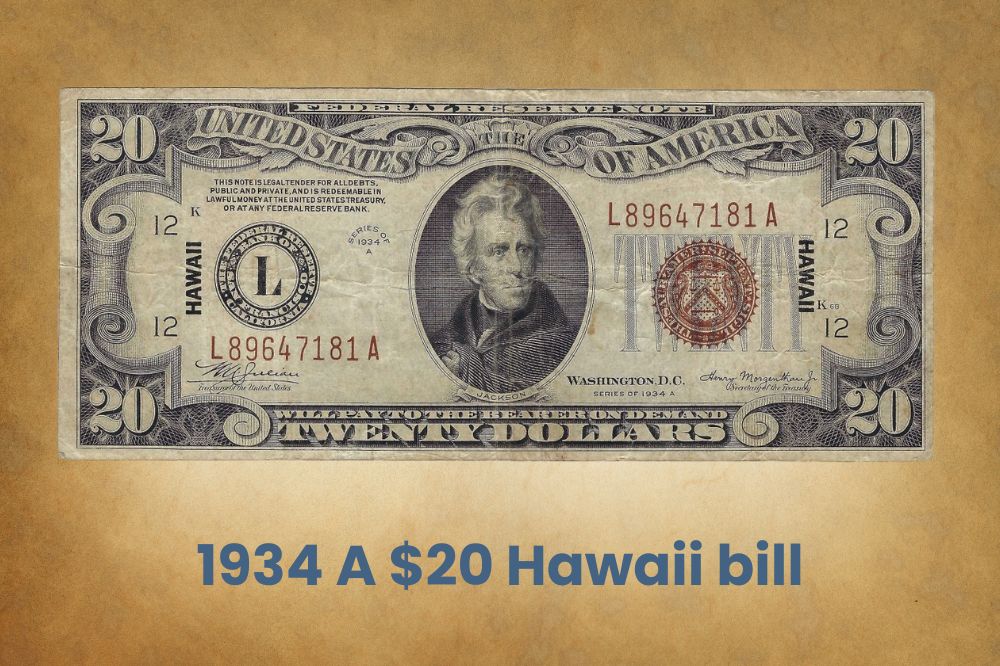
Hawaii Pearl Harbor notes are rare and expensive, and many collectors are prepared to pay $1,000 to $2,500 for the never used one. If you have one with a star, you can expect to get at least $3,000 for it.
The 1934 A variation is less desirable but is still valuable. Its average price on the market is $750 to $900, while pieces with a star can be even more pricey. Notes that spent some time in circulation are surprisingly cheap. You can find them for approximately $30 to $165, depending on the preservation level.
1934 $20 Bill Errors
Errors are not common in American banknotes because of strict control. However, you can sometimes come across pieces with atypical imperfections, particularly on the front page. Those banknotes are always more expensive than regular ones.
Misprinted bill
Sometimes, you can notice a misprinted 1934 $20 bill. This banknote with mismatched serial numbers on the front page is a rare piece, thanks to rigorous quality control and high standards during printing.
However, a few notes were missed and released into circulation. They are typically costly, and you can expect to get at least $500 per piece.
Star notes
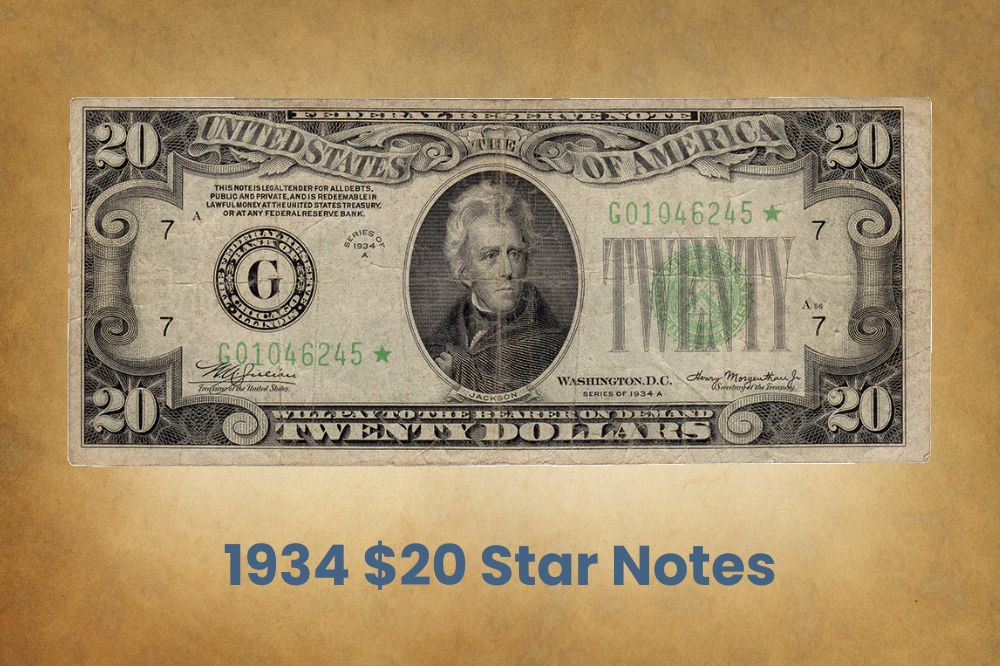
The 1934 $20 bill with a star instead of the last letter in the serial number represents a replacement note and can be valuable. Their price varies, depending on the federal reserve bank, but you can count on some additional cash for such a piece.
History of the 1934 $20 Bill
The Philadelphia mint produced the first US $20 bill during the Colonial Period in 1775. Then, the first confederate $20 bill appeared in Richmond, Virginia. They are rare nowadays since most Confederate currencies were destroyed after the Civil War.
Congress authorized the new $20 bill design in 1861 when the Federal Reserve printing period began. You can recognize two banknote types produced in those times:
- 1862 & 1863 $20 Legal Tender Notes
- $20 national bank notes
1934 small size $2 bill series |
||
| Series | Production period | |
| Printing start | Printing end | |
| 1934 | 2nd February 1935 | (the last delivery date is unknown) |
| 1934 A | Probably 1938 | (the last delivery date is unknown) |
| 1934 B | 29th November 1945 | (the last delivery date is unknown) |
| 1934 C (old reverse) | 7th January 1947 | (the last delivery date is unknown) |
| 1934 C (new reverse) | 27th July 1948 | (the last delivery date is unknown) |
| 1934 D | 13th January 1950 | 29th January 1951 |
| 1934 Hawaii | During WWII | |
| 1934 A Hawaii | During WWII | |
The $20 bill printed in 1928 was a gold certificate, but all later issues lost the possibility of getting gold instead of paper money.
Besides regular 1934 $20 banknotes, you can also find 1934 Hawaii Pearl Harbor $20 bills printed a few months after Japanese planes attacked Pearl Harbor. These notes with a brown seal were for exclusive use in Hawaii and the Pacific and are still collectible.
how to identify 1934 $20 Bill
Both 1934 $20 bill sides have the number 20 in all four corners, with THE UNITED STATES OF AMERICA on the top edge and the denomination TWENTY DOLLARS below.
The front page of the 1934 $20 bill
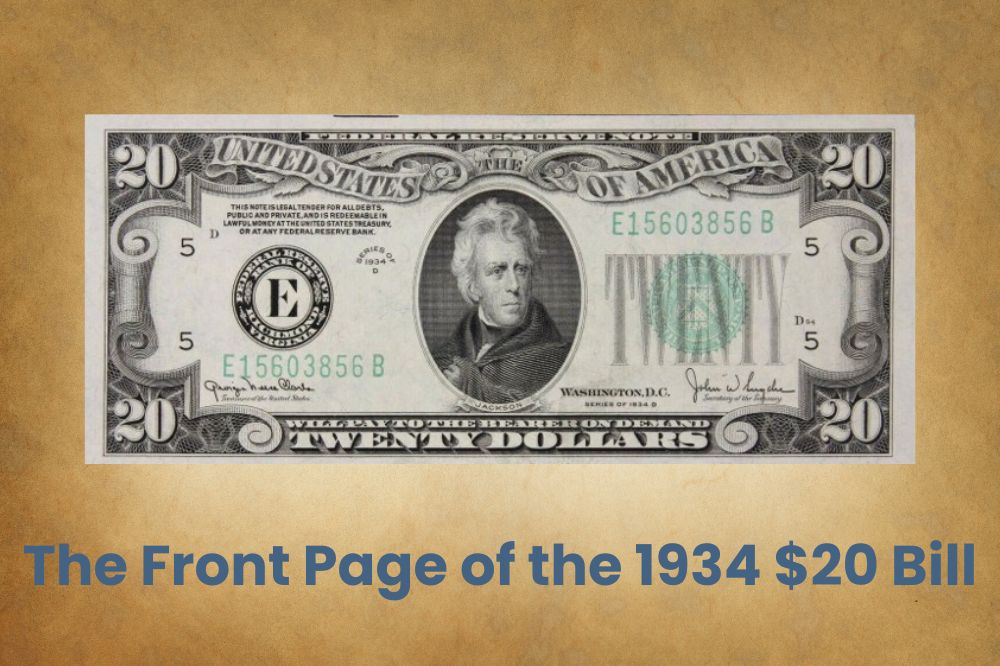
The 1934 $20 bill has President Andrew Jackson’s portrait on the front page. Beside the green seal on the right side, you can see the serial number on the top right and bottom left corners. Since all twelve districts printed these banknotes, you can notice any of the first twelve letters included in the serial number.
The 1934 Hawaii Pearl Harbor $20 bill is a bit different. Even though the design is the same, you can see two words HAWAII on the right and left edges. They are overprinted in bold letters, and the seal is brown.
The back page of the 1934 $20 bill
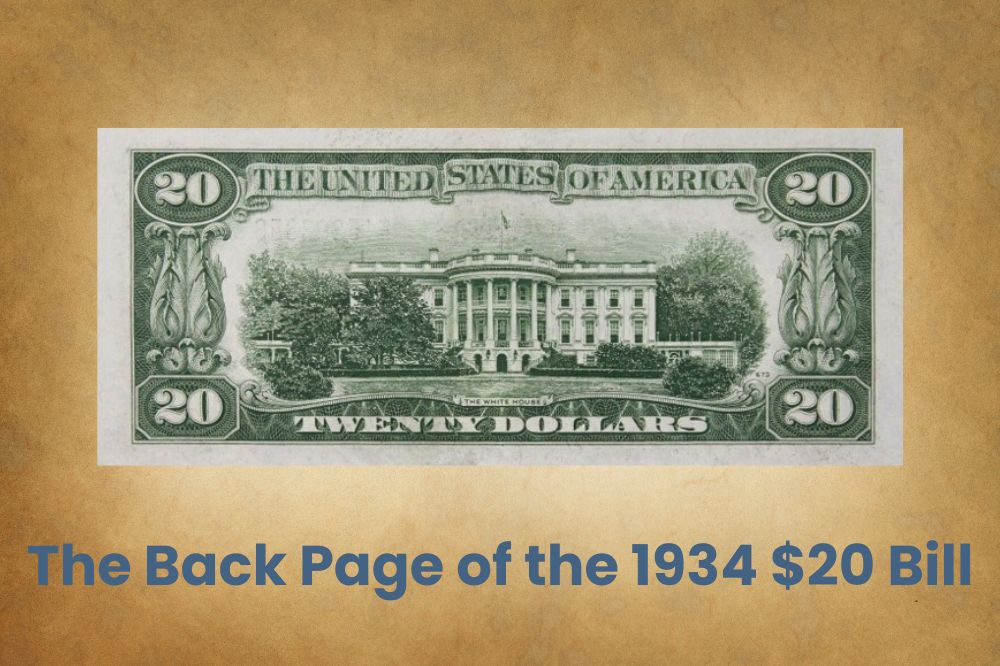
The 1934 $20 bill back page is beautifully decorated and skillfully designed. It contains a vignette with a centrally positioned White House surrounded by lovely trees. The 1934 Hawaii Pearl Harbor $20 bill has the Hawaii overprint on the entire backside.
1934 $20 bill |
|
| Face value | $20 |
| Type | Federal Reserve note |
| Producer | The US Bureau of engraving and printing |
| The front page | The 7th American President, Andrew Jackson |
| The back page | The White House |
| Material | Three-fourths cotton and one-fourth linen |
| Series | Five (1934, 1934 A, 1934 B, 1934 C, 1934 D) and two Hawaii (1934 and 1934 A) |
| Bill height | 2.60937 inches (66.28 mm) |
| Bill width | 6.14062 inches (156 mm) |
| Bill weight | 0.03527 ounces (1 g) |
| Seal variety | Green (brown in Hawaii notes) |
| Shape | Rectangular |
| Security features | Red and blue security fibers and raised printing |
Other features of the 1934 $20 bill
The 1934 $20 bill comes with a stylish design, distinctive look, and standardized texture, printing, and paper quality. Besides the central image, you can see adequate seals and signatures on these notes.
Seals
The Federal Reserve bank seal is always on the front page’s left side. It is black, while the treasury seal placed on the right side has changed over time. The 1934 $20 bill has a green seal, while the 1934 Hawaii Pearl Harbor $20 bill comes with a brown treasury seal.
Serial number
Each $20 bill has a serial number combining ten symbols, including two letters and eight digits. You can notice two serial numbers on the front page, which need to be identical.
However, it is possible to find a banknote with two different number rows with typically only one altered digit. Such a note is rare and is valuable for collectors as an error.
While numbers determine the series year, the letter shows the Federal Reserve bank that printed each particular note. Every letter from A to L refers to one city.
Interestingly, you will never see the letter O in the serial number. It is necessary to avoid possible misunderstanding since it is similar to zero. Another no-no letter is Z since it is reserved for test printing.
Some notes contain a star instead of the last letter. It signifies that an imperfection appeared on the original sheet during manufacturing. Since printing two identical banknotes is strictly forbidden, placing a star is a way to release a correct bill into circulation.
Special Serial Numbers |
||
| Type | Serial | |
| Number 1 serial | A00000001A | Up to $15,000 |
| Low serial (under 100 or 1,000) | Up to A00000099A or A00000999A | $20 to $100 |
| High serial | A99999900A and higher | Especially prized |
| Perfect up ladder (and partial up ladder) | A12345678A (for example, A00012345A) | Especially prized |
| Perfect down ladder (and partial down ladder) | A87654321A (for example, A87654000A) | Especially prized |
| Birth year serial | For example, A00001970A | Especially prized |
| Solid serial number | For example, A88888888A | $500+ |
| Seven numbers in a row (the 5s) | A45555555A | Especially prized |
| Double quad | For example, A88884444A | Especially prized |
| Super repeater (and partial repeater) | For example, A23232323A (A00232323A) | A few hundred dollars |
| Palindrome (radar) | For example, A00088000A | Especially prized |
| Super radar | For example, A54444445A | Especially prized |
| Flipper (69 or 96 somewhere) | For example, 0006900 | Up to a few hundred dollars |
| Binary super-repeater or binary (only 1s and 0s) | A01010101A (A10101110A) | $900+ |
Besides regular serial numbers, collectors often look for banknotes with a unique number row worth more money. The most desirable are a perfect up ladder, binary super-repeater, solid serial number, and low serial, particularly the number 1 serial.
Signature
The US Bureau of engraving and printing produced five 1934 $20 bill types, plus two note types for Hawaii printed during WWII. All seven types have two signatures on the front page, like all other US banknotes:
1934
- Treasury Secretary Henry Morgenthau Jr.
- Treasurer William Alexander Julian
1934 A
- Treasury Secretary Henry Morgenthau Jr.
- Treasurer William Alexander Julian
1934 B
- Treasury Secretary Frederick Moore Vinson
- Treasurer William Alexander Julian
1934 C
- Treasury Secretary John Wesley Snyder
- Treasurer William Alexander Julian
1934 D
- Treasury Secretary John Wesley Snyder
- Treasurer Georgia Neese Clark Gray
1934 Hawaii
- Treasury Secretary Henry Morgenthau Jr.
- Treasurer William Alexander Julian
1934 A Hawaii
- Treasury Secretary Henry Morgenthau Jr.
- Treasurer William Alexander Julian
Printing
Since the $20 bill has the same printing type as other US banknotes, you can feel raised texture while moving a finger along its surface. It is impossible to counterfeit it, so you can be sure that such a bill is genuine.
Paper
As all other Federal Reserve notes, the 1934 $20 bill is made of paper containing three-fourths cotton and one-fourth linen. You can notice red and blue security fibers on each banknote.
FAQ about the 1972 Lincoln Penny
What makes a 1934 $20 bill rare?
Only banknotes printed in Hawaii are rare nowadays, particularly those in an uncirculated condition. Besides, all pieces with a star are rare and highly collectible.
Which 1934 $20 bill is worth a lot of money?
The 1934 Hawaii Pearl Harbor $20 bill with a brown seal is the most expensive in a series. Collectors often pay at least $3,000 for one in uncirculated condition.
How much is the 1934 $20 bill worth?
The used 1934 $20 bill with a green seal typically costs $20 to $50, while you should pay $75 to $100 for a piece in uncirculated condition. Banknotes printed in later years are always less desirable among collectors and thus less valuable.
What is the rarest 1934 $20 bill?
The rarest in the series is the 1934 Hawaii Pearl Harbor $20 bill with a brown seal. It is worth over $1,000, but some specimens can be worth much more. The most appreciated is the one with a star since it is hard to find it in an uncirculated condition.

1934 a Washington Well worn E41413807 A how much is it worth